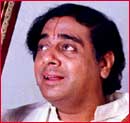Maestro Seshagopalan renders 12-hour concert
T K Sreevalsan and M Karthikeyan in Madras
It was at the eighth hour of his concert that Madurai T N Seshagopalan chose to sing the early morning Raga Bhoopalam, ushering in the break of a new day.
 He still had another four hours to complete a challenging task.
He still had another four hours to complete a challenging task.
At 0830 hrs, when the Carnatic maestro concluded his recital with a piece in Raga Abhogi amid unexpected showers, he had accomplished a rare feat in the recent history of the 400-year-old South Indian classical music form -- giving a 12-hour
concert at a stretch.
Even as the nondescript dais at the open-air hall in the city saw eight batches of accompanying artistes taking turns since the
marathon rendition began ten minutes past 2000 hrs, the 51-year-old exponent carried on with his characteristic verve in the voice.
The end of which underscored his physical stamina and mental prowess, besides the range and richness of Carnatic music.
''It (programme) was an effort to revive the trend of giving long concerts as two-hour katcheris (musical programmes) have become the order of the day,'' said Seshagopalan, who has been a frontline Carnatic musician since the mid-1970s after being trained by a lesser-known guru, Ramanathapuram Sankarasivam.
''Let me hope that next year, if a similar attempt happens, it will be some other musician(s),'' he added at the Ayodhya Mandapam,
the venue for the pioneering Vishnugananjali rendition under the aegis of his newly-founded Guru Kripa Trust on the occasion of the
auspicious Vaikuntha Ekadasi.
There was excitement in the air as music lovers thronged the asbestos-roofed auditorium adjacent to the bustling Arya Gowder road
to listen to the concert. Crowded buses ponked horns while autorickshaws scurried past during the first couple of hours since
the start of the concert but neither the singer nor the audience
seemed to bother.
The selection of the first few compositions made clear that bringing out the contrasting moods of each raga was one of the main
intentions of the concert. Starting off with a Purandara Dasa piece, Jaya Narayana, in the refreshing Raga Humsadhwani, Seshagopalan next sang a composition tuned the coy Kamas, followed by the majestic-sounding Devagandhari and then in Raga Thodi, arguably the most popular Carnatic raga.
He also ensured audience participation by making them sing some bhajans, with him playing the harmonium. He also regaled the audience by narrating stories behind the
evolution of some compositions he sang, as well as interesting details about their literature and episodes from his own life on and off the stage.
Besides the customary violin, mridangam, ghatam and kanjira, Seshagoplan used instruments like the flute and dholak.
More than two dozen keertans, covering all major composers, figured in the performance, which also had two ragam-tanam-pallavi pieces besides four taniyavartanams (percussion concerts).
Kanchi seer Jayendra Saraswati inaugurated the function in which Seshagopalan was conferred Divyaprabanda Sangitha
Chakravarthi by the city-based Bharat Kalachar Sabha.
Prominent accompanying artistes at the programme were violinists M Chandrasekharan and M A Sundaresan, mridangists Guruvayur Dorai, Srimushnam Raja Rao and Mannargudi S Eswaran besides T V Vasan and S Karthick (ghatam).
UNI